In this opart Paul McCarthy introduces us to wine-making in three countries in the western end of North Africa, Algeria, Morocco and Tunisia.
Algeria
Wine making in Algeria was started by the Phoenicians and continued by the Romans. Production continued until the Muslim conquests of the 7th and 8th centuries greatly reduced the output. In more recent times, it was the French who were responsible for reviving production. There are more hectares of vines under cultivation here than in South Africa or Germany. When the phylloxera epidemic ravaged French vineyards from 1863 onwards, it was the wines from Algeria which helped to plug the gap. They were used by the French to blend with home produced wine, thus ensuring that French production levels could still be maintained.
The late 1930s saw wine-production at its peak, with over 4,000 sq kilometres under cultivation, producing a total output of around 455,000,000 imperial gallons. By the late 1950s, together with the output from Morocco and Tunisia, the 3 countries accounted for two thirds of the wine being traded internationally. The French still continued to blend Algerian wines with their own, due to their deeper colour, more robust nature and higher alcoholic content. They thought so highly of the wines, that by 1962 over a dozen areas were classified by them at the Vin Délimité de Qualité Superieure (VDQS) status.
When Algeria was granted its independence in 1962, the local industry once again suffered. Through the combination of French settlers leaving, the French army pulling out and a sizeable reduction of the French demand to take Algerian wines for blending, both local consumption and exports significantly diminished. The Soviet Union did step in with a deal for around 132,000 gallons per annum until 1975, but at prices below market value. Today, Algeria is more known for producing grapes to be consumed as a table fruit rather than drunk. However, there remains a small but highly regarded group of wine producers carrying on the tradition.
Algeria's vineyards are located in the Hauts Plateaux region. They enjoy a typical Mediterranean climate, similar to that found in Southern Spain, hot summer days (cooling in the evenings) with mild and dry winters. Grape varietes used for wine production include Carignan, Cinsault, Cabernet Sauvignon, Merlot, Syrah, Alicante Bouschet, Clairette Blanche, Chardonnay and Mourvèdre. Typically Algerian wines are characterised by their overripe fruit, high alcohol and low acidity. The grapes often go through a short fermentation process and are then bottled after a little or no oak ageing.
Let us look at some wines and the wine-maker behind them. The Société des Grands Crus de l'Ouest (SGCO) was founded by Rachid Hammouche in 2001. His mission was to produce premium quality wines and he recruited a team of experts that shared his passion. Their cuvées (Saint Augustin, Koutoubia and Fleur d'Aboukir) have gained high reputations both among chefs and sommeliers of the country's top restaurants.
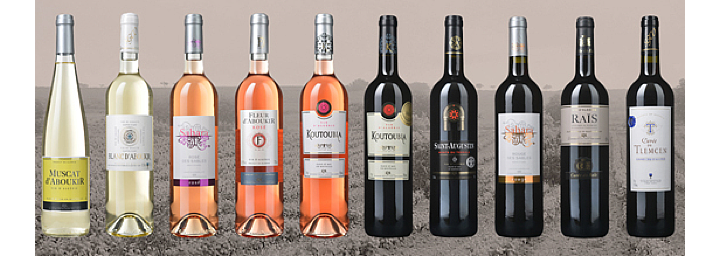
As this reputation grew, SGCO found they were limited in the number of bottles and range of wines which could be produced from their own vineyards. So they started to work with other vine-growers, imparting their knowledge and expertise. This has ensured that the external growers deliver a range of grapes which have been cultivated to a high and consistent quality level. SGCO currently offer 20 different bottled wines plus a red in a box. Here are 3 examples of the range.
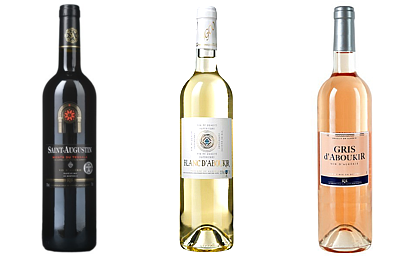
Red – Saint Augustin
NOSE: Black fruits with hints of menthol
PALATE: A full and generous bodied wine with silky soft tannins and a lingering finish
FOOD PAIRING: Meats such as beef, venison, lamb and hard mature cheeses
SUMMARY: Made from grapes grown in Sidi Bel Abbès (West Algeria). The wine is a blend of Grenache, Cinsault, Alicante Bouschet, Carignan and Mourvèdre grapes. It has won international awards including 2 silver medals in 2014 (Medal Vinalies) and in 2019 (Medal Lyon) respectively. Best served at around 18-19 °C and opened an hour before. Merchants are selling bottles in the range of £6 to £12.
White – Blanc D'Aboukir
NOSE: White flower blossom with citrus notes such as lime zest
PALATE: A big soft fruit flavour that is well balanced with light acidity and has a long clean finish
FOOD PAIRING: Chicken and turkey, grilled fish and crustaceans such as prawns, shrimps and langoustines, grilled eggplant
SUMMARY: Made with a blend of Merseguera and Clairette grapes. Serve at 10 to 12 °C. Wine merchants are selling this wine for between £6 and £12 a bottle.
Rose - Gris D'Aboukir
NOSE: Small red berries with hints of minerals
PALATE: Soft red berries balanced with light tannins, delivering a clean, elegant and refreshing experience
FOOD PAIRING: Lamb, game (particularly guinea fowl and grouse), grilled prawns and shrimps, grilled sardines and whitebaitSUMMARY: Made from the Cinsault grape. Serve at 10 to 12 °C. Wine merchants are selling this wine for between £10 and £18 a bottle.
Morocco
Like Algeria, wine-making in Morocco was began with the Phoenicians, continued and evolved under the Roman Empire, with France having a major impact on its output in more recent times. The Muslim conquests within the region greatly impacted on wine production before the French revived the industry.
Production has never hit the levels seen in Algeria. By the time of independence from France during 1956, only 140,000 acres of vineyards were under cultivation. Once the French left, wine-making still continued with only minimal impact on production and consumption until 1967 when the EEC introduced a quota system for the importation of wine. This resulted in a major downturn for the industry and many producers gave up. The state took over many vineyards. Grapes suitable for the table were then grown instead, with the wine producing varieties either dug up or poorly maintained. This led to a major decline in the industry, resulting in many vines becoming diseased or having low yields. Only 32,000 acres remained under cultivation by the early 1990s and many were not in the best of condition.
The industry gained new life from the 1990s when King Hassan II took an interest. As a result of his efforts, foreign investments started to come in and revitalise the industry. Existing vines were salvaged where possible. Those that were diseased or past their best years were dug up. A program for planting new vines commenced. It was primarily still the French who gained new interest in the Moroccan wine industry.
Foreign wine companies were offered long-term leases on vineyards by the state agricultural company SODEA. Several large Bordeaux based wine companies, including Groupe Castel, William Pitters and Taillan, decided to take up the opportunity. Today, they and others have ensured that the Moroccan wine industry is a flourishing industry. There is a wide range of wines and styles being produced, from day to day table wine right through to the more high end specialist wines.
The Atlantic facing side of the Atlas Mountains makes for ideal conditions to cultivate vines. There are 14 areas within five distinct regions where wine is produced. Approximately 75% of the total output is red. Grape varieties include Carignan, Cinsault, Cabernet Sauvignon, Merlot, Syrah, Grenache, Chenin Blanc, Sauvignon Blanc, Chardonnay, Clairette Blanche and Muscat. The special climatic conditions, with cooling Atlantic breezes, allow for some grape varieties to be cultivated which are impossible in most of the wine-making regions around the Southern Mediterranean.
Brahim ZNIBER started his wine-growing venture in 1956. The business has evolved over time and now trades as Les Celliers de Meknès. They are acknowledged as the largest and best-known wine producers in Morocco today. Meknès were the first to plant many international grape varieties such as Chardonnay and Cabernet Sauvignon. They were also the first to use oak barrels for ageing. Located in the foothills of the Atlas mountains, the estate's vineyards cover 2000 hectares (4950 acres) at altitudes from 580–700 m (1900–2300 ft) above sea level. On these slopes, the altitude moderates the warm climate while offering plenty of sun and a variety of soil types which can be exploited. Here are 3 examples of their wine range.
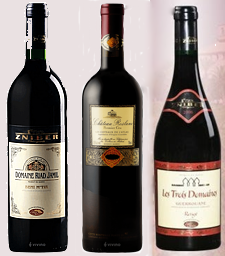
Red - Château Roslane Premier Cru Rouge
NOSE: Blackberries, ripe dark plums with cedar wood cigar box notes
PALATE: A big full bodied wine that combines the big dark fruit flavours with hints of dark chocolate that slowly fade to a clean red berry finish
FOOD PAIRING: Roast meats such as beef and venison, casseroles and stews, strong well hung game such as pheasant, mature hard tangy cheeses
SUMMARY: Made from a blend of Cabernet Suavignon, Merlot and Syrah grapes. A big wine to be savoured. Serve at 17 to 18 °C and open at least an hour before drinking. Decanting after opening recommended. It will set you back £25 to £50 a bottle but is worth experiencing and will impress sceptics who say Morocco cannot produce wines at this level.
Red – Domaine Riad Jamil
NOSE: Dark ripe berries and hints of dark chocolate
PALATE: A full bodied wine that combines the dark fruit flavours with soft tannins giving a warm rounded flavour
FOOD PAIRING: Roast meats such as beef and venison, casseroles and stews, lightly spiced dishes and lamb tagine, hard medium strength cheeses
SUMMARY: Made from the Carignan grape. A good everyday wine to be enjoyed best when served at 17 to 18 °C. Merchants are asking £6 to £12 a bottle.
Red – Les Trois Domaines Guerrouane
NOSE: Dark cherries and red berries
PALATE: A well rounded wine with the sweetness of dark cherries balanced with the acidity of red berries
FOOD PAIRING: Grilled meats and fish, meze and lamb tagines, soft and hard cheeses that are not tangy or too acidic
SUMMARY: Made from a blend of Carignan, Cinsault, Alicante and Grenache grapes. A good everyday wine to be enjoyed best when served at 15 to 16 °C. Merchants are asking £9 to £15 a bottle.
Another interesting Moroccan wine maker is Thalvin. In partnership with local landowners in Rommani, a region of rolling hills situated at the base of the Atlas Mountains (at an altitude of 2000 feet), they have planted vines where the black soil has a chalky clay subsoil and emerging rock. This particular terroir, along with the climatic conditions, provide the ideal environment in which to grow grapes enabling the production of quality wines. Grapes are hand picked and there is no use of herbicide or fungicide. So technically these grapes are grown organically. I have selected 3 of the wines in their range for review.
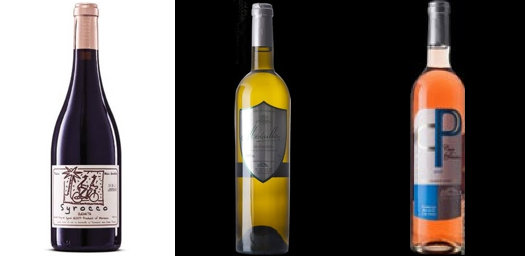
Red - Domaine des Ouled Thaleb Syrocco
NOSE: Apricots, floral and grapefruit notes
PALATE: Fresh white soft fruits with a refreshing grapefruit acidity
FOOD PAIRING: Grilled white fish (sole, place, turbot), seafood, pasta salads, lemon chicken
SUMMARY: Made from the Syrah grape. It is a good everyday wine, but should not be thought of as a Vin de Table. Best served at 16 to 18 °C. Merchant prices range from £12 to £20 a bottle.
White - Domaine des Ouled Thaleb 'Medallion' Sauvignon
NOSE: Citrus zest mixed with hints of apricot and peach
PALATE: A refreshing well balanced wine, whose mix of soft fruit and citrus flavours make for a more complex wine as you work your way down the glass.
FOOD PAIRING: Light meats such as chicken and pork, soft white cheeses, white fish. Not one to enjoy with spicier food. Enjoyable though as an aperitif.
SUMMARY: Made from the Sauvignon Blanc grape. A nice refreshing wine which is at its best when served at 9 to 10 °C. Ideal if you are looking for something a bit different to serve at a dinner party or a picnic. Merchant prices range from £15 to £20 a bottle.
Rose - Domaine des Ouled Thaleb Cuvée du President Rosé
NOSE: Fresh strawberries with rose hip and red grapefruit citrus notes
PALATE: The strawberry flavours are balanced with acidity to produce a rounded and refreshing wine.
FOOD PAIRING: Light meats such as chicken and pork, soft white cheeses, white fish. Not one to enjoy with spicier food
SUMMARY: Typically made from a blend of 50% Cinsault, 40% Grenache and 10% Cabernet Franc. Due to the grapes used, it needs a little time to mature. Look for bottles that have 2 to 3 years ageing, or one worth investing in to lay down for a couple of years. Serve at 10 to 11 °C. Merchant prices range from £15 to £25 a bottle.
Tunisia
As with Algeria and Morocco, wine-making in Tunisia was first undertaken by the Phoenicians. It was then revitalised during the Roman Empire, experienced a major downturn from the Muslim Conquests and then rejuvenation once again under French rule.
During French rule production flourished, reaching a higher production level than Morocco, but far short of Algeria. Independence in 1956 from France saw most of the expertise leave the country and the industry fell into decline. The EEC quota system brought in during 1967 further impacted production levels.
From the late 1990s, foreign investment has been steadily going into the industry This has resulted in a modest year on year growth for production levels. There was also a steady growth in the acreage of vineyards being cultivated. By 2008, the recorded acreage under cultivation had reached 40,000, producing around 500,000 litres of wine. Today the industry has grown around 76,000 acres delivering an output of 40 million bottles. Around 60% of production comes through a government sponsored co-operative. We will take a look at some of the wines produced through this support by Les Vignerons de Carthage. Just five privately owned wineries are in operation. One that has gained an international reputation and exports its' wines is Ceptunes.
France and Germany are the major export destinations, with Switzerland, Belgium, USA and Canada being significant secondary markets. Eastern Europe is a growing export market. Over 65% of the wines produced are surprisingly Rosé, with around 25% Red and under 10%.White.
Wine-making is centred within the Cap Bon peninsular. With the Gulf of Hammamet on one side and the Gulf of Tunis on the other, together with fertile land, plenty of sunshine, moderate rainfall and a cooling sea breeze, conditions are ideal for growing grapes. Grape varieties include Carignan, Cinsault, Mourvèdre, Grenache, Syrah, Merlot, Alicante Bouschet, Muscat, Chardonnay and Pedro Ximenez.
Here are 3 examples of the wines produced by the state supported Les Vignerons de Carthage.
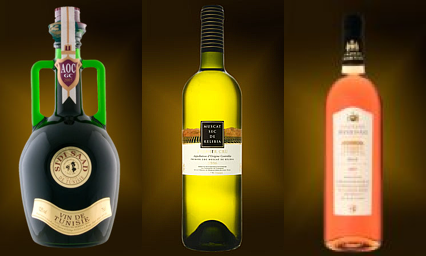
Red – Château Mornag
NOSE: Dark berries and plums with a hint of balsamic vinegar
PALATE: Full bodied with ripe dark fruit flavours and soft tannins giving a pleasant rounded experience
FOOD PAIRING: Grilled lamb, stews and casseroles, spiced dishes and tagines.
SUMMARY: Made from a blend of Cabernet Sauvignon and Syrah grapes. A good every day wine that is more than just a Vin de Table. Serve at around 16 °C. Merchant prices range from £6 to £10 a bottle.
White - Muscat de Kélibia
NOSE: Fragrant flowery notes with hints of acid drops
PALATE: Fresh oranges balanced with jasmine and citrus fruit zest
FOOD PAIRING: Salads such as avocado or prawns, creamy pasta dishes, grilled white fish with a buttery sauce, fois gras and pates, sheep and goat cheeses
SUMMARY: Made from the Muscat of Alexandria grape. A warm rounded wine that is not in itself a sweet wine but not for those looking for a crisp white. Best served at 10 to 12 °C. Merchant prices range from £6 to £10 a bottle.
Rosé - Château Mornag Rosé
NOSE: Red berries balanced with peaches
PALATE: Clean light red fruit flavours and low acidity
FOOD PAIRING: Grilled meats and fish, prawns and crab, salads and cold pasta dishes
SUMMARY: Made from a blend of Cinsault, Carignan and Merlot. Serve at 10 to 12 °C. Merchant prices range from £6 to £10 a bottle.
Ceptunes was founded in August 2000. In 2002 they completed the building of their Cave Vinicole de Grombalia. The town of Grombalia is located in the Cap Bon peninsular and has Andalusian origins. It was awarded the status of “International City Of Wine” at the 1987 wine festival in Rome. The company produces over 20 different wines covering red, white and rosé. The wines are made from both their own vineyard as well as grapes grown by local farmers under the direction of the Ceptune team. From their range I have selected the following 3 for review.
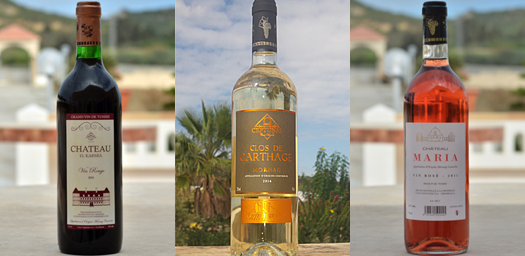
Red – Château El Karmia
NOSE: Blackberry jam and hints of ripe dark plums
PALATE: Full bodied with ripe dark fruit flavours combined with soft rounded tannins and an aromatic finish
FOOD PAIRING: Grilled lamb, venison and game such as pheasant, stews and casseroles, spiced dishes and tagines.
SUMMARY: Made from a blend of Carignan and Mourvèdre grapes. Serve at 15 to 17 °C. Merchant prices range from £10 to £15 a bottle.
White – Clos De Carthage
NOSE: Fresh flowers with citrus marmalade and bergamot notes
PALATE: White fruits with soft acidity and light lemon finish
FOOD PAIRING: Grilled fish and shellfish, chicken and pork, salads. Also enjoy as an aperitif
SUMMARY: Made from a blend of Chardonnay and Sauvignon Blanc grapes. Best served at 7 to 9 °C. Merchant prices range from £6 to £10 a bottle.
Rosé - Château Maria
NOSE: White fruits and gooseberries
PALATE: Peaches and redcurrants with soft tannins giving a clean refreshing finish
FOOD PAIRING: Grilled meats and fish, soft and hard cheeses that lack age and maturity, salads and cold pasta dishes
SUMMARY: Made from a blend of Carignan and Mourvèdre grapes. Ideal for summer picnics and barbecues. Serve at 10 to 12 °C. Merchant prices range from £6 to £10 a bottle.
The 3 countries featured in this part of the Middle East and North African series are not usually considered as producers of quality wines. I hope that my review has given you some insight into the history and wine production today. Should your local supermarket or wine merchant have wines from the region for sale, do pluck up the courage to buy a bottle or two. I am sure you will be pleasantly surprised rather than disappointed. If the region did not produce good wines, then why would the French be so interested?
For the next part of this series, I will put the spotlight on just one country, Israel. There is a lot to cover as Israel has hundreds of wineries producing a comprehensive range. Their reds, whites and rosés extend from day to day drinking through to the very high end. They also produce sparkling wines made using the classic Champagne method. So there will be a lot to get through and discoveries made.
Happy Tasting.

